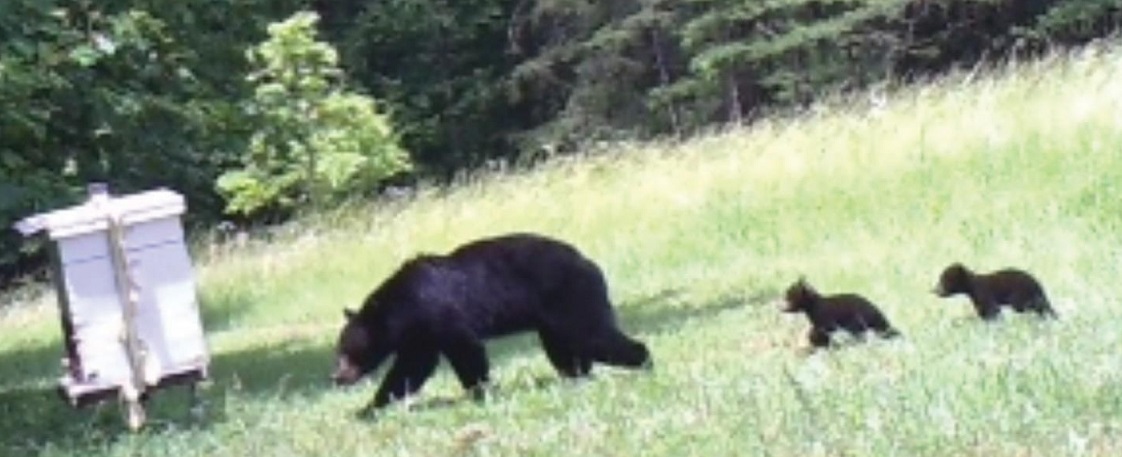 By Joseph A. May, DVM
By Joseph A. May, DVM
With the increase in the bear populations, bear sightings are on the increase even in suburban and metropolitan areas. This in turn puts many small backyard apiaries at risk for bear predation. It’s hard for a bear to resist the smell of honey and bee larvae and they can destroy an entire apiary in a single night. This fact became clearly evident to me when my neighbor posted a video of two large bears on Facebook less than a hundred yards from my back yard, followed by five additional neighborhood sightings in less than a week. More recently, my dentist shared the above trail camera photo with me from about five miles away; sadly, the hive is no more.
I knew I needed to do something to protect the four hives that reside in my back yard, so I hastily constructed an electric fence to surround the hives the same night I saw the video. However, I was not looking forward to the mowing and weed eating needed for maintenance and sought another option.

A friend who is a Conservation Officer with the Virginia Department of Game and Inland Fisheries saw the video and sent me a link for “Electrified Beehives a.k.a. The Hanger Hive Guard,” which is available on the VDGIF website along with videos demonstrating the effectiveness of an electric fence in deterring bears. It is basically an open-ended cage constructed out of hardware cloth that hangs over the hive on an insulated mat. I could see its merit, especially for hives on individual stands, but I wanted a simpler solution that I could construct from salvaged materials I already had on hand. I decided to attach the fence to my hive stand rather than to the hives themselves.
My four hives reside on a pair of stands constructed out of salvaged two-by-sixes mounted to galvanized posts. The open and elevated design along with screened bottom boards helps control varroa and other pests. I use a nontoxic herbicide to control weeds and apply diatomaceous earth beneath the stands to help control ants, beetle larvae, and other pests.

The fence was constructed using scrap two-by-fours and ripped two by-sixes I already had on hand to create two panels that were screwed to the ends of my hive stands. The horizontal supports were 36 inches and were added to two vertical members 38 inches long, attached so they hung 8 inches below the hive landing boards to give protection from skunks and smaller predators. The dimensions are not that critical but I wanted about 12 inches of clearance on the front of the hive and about 8 inches on the rear. Two pieces of one by four board were attached to the horizontal and vertical members to brace them and give extra support. The white pieces behind the insulators were made from a vinyl post surround scrap I salvaged and cut lengthwise. The vinyl reduces the number of insulators needed and prevents the wire from shorting out by keeping it off the frame where it goes around the corners. The same effect could be accomplished by attaching a piece of PVC pipe to the corners of the frames. The insulators are nail on insulators for wooden posts attached through pre drilled holes with screws instead The electrified bear fence, suspended from the existing hive stand. The galvanized posts are supports for the hive stand.
A second screw was added to give extra support and to keep the insulators from twisting. The frames were attached to the ends of the hive stands with screws in both the horizontal support and the brace board. Wire was strung between the insulators on the fronts and the sides. I ended up with six strands of wire protecting the front and sides of my hives. On the back side, I added two stands of wire with spring-loaded gate latches so the wire can be easily removed when working the hives. This could easily be increased to four strands by making the wire longer and doubling it through parallel pairs of insulators.
The fence is powered from an outdoor outlet 40 feet away, with an underground wire run from the charger to a distribution point and then to the two hives. In drier climates, a ground wire may need to be added between the hot wires to ensure that the intruder is grounded and gets a good dose of electricity. The charger may also be placed on a dusk to dawn timer so the fence is only on at night in low risk areas. I like this design because I can easily access my hives and mow around them with no obstructions. If no power is available, a solar powered charger and a battery can be used to power the fence.

The artwork on the end panel is courtesy of my grandchildren after providing them with some stencils, a pack of colored permanent markers, and a piece of corrugated plastic board commonly used as sticky boards for mite counts. It was easier and safer for them to decorate the board and attach it to the end panels than to decorate the occupied hives. The panel also has the added benefit of shading the hive on the west side from the hot afternoon sun.
The back side is equipped with spring-loaded gate latches for easy access. Here is my fence charger with my “bee fountain” in the foreground. Rocks in the lower fountain keep the bees from drowning and the bees love it.
(Reprinted with permission from May and the American Bee Journal, www.americanbeejournal.com. Donations to the Honey Bee Health Coalition may be mailed to the Keystone Policy Center, c/o Julie Shapiro, 1628 Sts. John Road, Keystone, CO 80435.)




